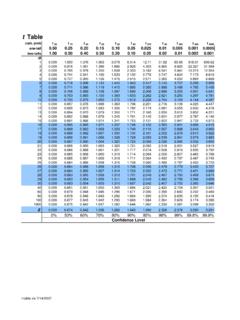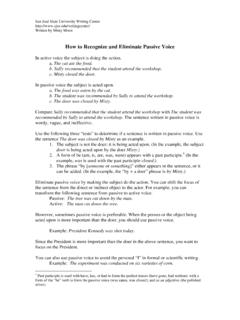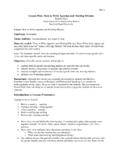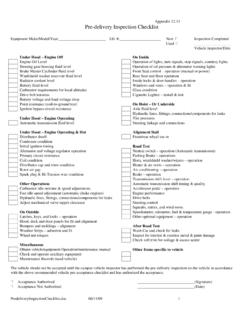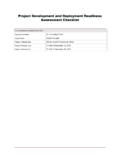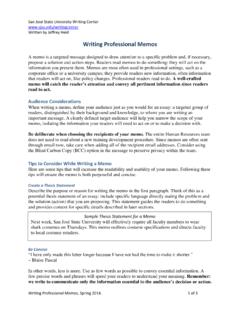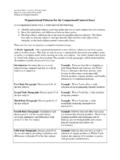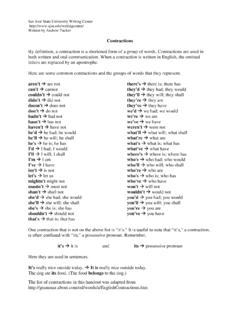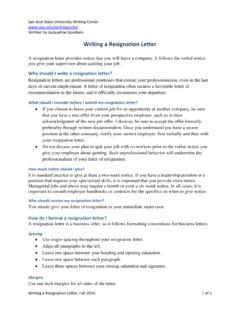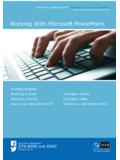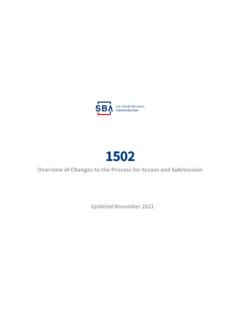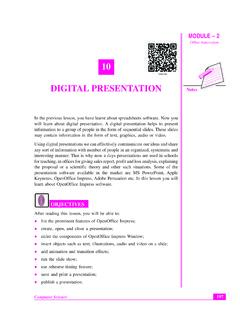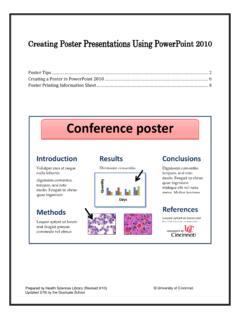Transcription of Using Signal Words and Phrases Lesson Plan
1 Albers 1. Lesson Plan: Using Signal Words and Phrases Patricia Albers Department of Art and Art History San Jos State University Lesson : Using Signal Words and Phrases Timeframe: 60 minutes Target Audience: Upper-division university students, both second-language learners and native speakers Materials needed: Laptop, LCD projector, powerpoint presentation, whiteboard or blackboard and markers, handout, writing materials for students, homework assignment sheet Objectives: After the Lesson , students will be able to recognize Signal Words and Phrases , incorporate Signal Words and Phrases in their writing, and consider structural relationships in their writing more carefully.
2 Background: Often student writers do not fully take into account what a writer owes his or her reader. Among other things, they struggle with establishing clear and meaningful relationships among the ideas they are presenting and with helping the reader easily grasp such relationships. This Lesson focuses on the use of transitional Words and Phrases so-called Signal Words and Phrases to show the reader that the writer is shifting to a different time or place or setting up, developing, challenging, or summarizing a set of ideas. Introduction to Lesson [5 minutes]: Start the powerpoint presentation. Give students the following information.
3 O Slide 1: Today we are going to work with Signal Words and Phrases , which are also called transitional Words and Phrases . o Slide 2: All semester, we have been saying that good writing serves its readers. Even when you are writing about yourself, your writing must attend to your readers' needs, not to your own. Keep thinking about the following questions: Who are my readers? What do they know? What don't they know? What more can I do to help them understand and follow what I am saying? o Slide 3: There are many ways to serve your readers. One way is by Using Signal Words and Phrases . o Slide 4: Think for a minute about driving. When traffic situations are complex, good drivers use turn signals to let other drivers know their intentions.
4 Albers 2. o Slide 5: Road signals tell other drivers where you are going. Similarly, Signal Words tell your readers where you are going. When writing relationships are complex, good writers use Signal Words and Phrases to help readers follow without having to stop and puzzle out the relationships. Here are some examples of Signal Words and Phrases : as a result, nevertheless, at the same time, and similarly.. Yes, I have used a Signal word here ( similarly ) to let you know that I am about to point out something that is like Using turn signals. A Signal word picks up an element in the previous sentence and shows where you intend to take it.
5 Procedure [45 minutes]: Step 1: Read and discuss two texts [10 minutes]. Hand out the two texts about making banana pizza and ask students to read them. Meanwhile, show Slide 6. Ask students which of the two texts is better and why. In the short discussion that follows, you want students to realize that not only is the text on Side B easier to read, but it also helps the reader better understand the process of making the pizza. show powerpoint slides 7 and 8 (which are identical to the second text) and ask students to explain what kinds of relationships are set up by the Signal Words and Phrases . sequence [first, then, next, finally].
6 Contrast [alternately, but, however]. emphasis [in fact, yes]. time [meanwhile]. likeness [equally good]. summary [finally]. Note to instructor: The categories of Signal Words and Phrases are consistently color-coded on the powerpoint slides . For example, Words and Phrases that Signal contrast are orange. The color-coding will help some students better connect the concept with the actual Words and Phrases . Step 2: Continue powerpoint presentation [5 minutes]. Slide 9: Read each category aloud and ask different students to read the examples of Signal Words and Phrases .* Ask students if they can add another Signal word or phrase to each category.
7 For example, in the first category, time, they might add at the same time.. Albers 3. Slide 10: Read the text. Explain the transition we are now making in our class discussion: we are adding to our discussion of Using Signal Words and Phrases in a process piece (such as making a banana pizza) and also talking about Using Signal Words in an argumentative piece. Slide 11: Ask a student volunteer to read the text. Once this task has been completed, explain to students that argumentation in which the writer takes a position and tries to convince others of its correctness is a particularly complex type of writing. It can involve many strategies.
8 The writer must present reasons why his or her argument is correct and support those reasons Using examples, statistics, analogies, and so on. He or she must also acknowledge and address potential objections. Given all this complexity, it is vital to use Signal Words and Phrases in argumentative writing. Step 3: Ask students to write and peer-review a paragraph Using Signal Words and Phrases [15 minutes]. Project Slide 12 so the students can view the list of common Signal Words and Phrases . Ask each student to write a paragraph that uses Signal Words and Phrases . This paragraph should explain a process: how to make a work of art or craft Using a particular medium (like photography, papier-m ch , watercolor, etc.)
9 Write these instructions on the whiteboard. Before students begin, provide the following information: o Tell them to try to use as many different kinds of Signal Words and Phrases as possible. o Remind them that a Signal word or phrase does not have to come at the beginning of a sentence. It can come in the middle or at the end. o Also tell them to consider the right Signal word or phrase. For instance, however and on the other hand both Signal contrasts, but they do not mean exactly the same thing. However shows that you are about to contradict (or partly contradict) what you have just said. On the one hand and on the other hand stress the fact that you are presenting two opposing ideas.
10 Both in conclusion and all in all introduce a summary, but in conclusion is appropriate for a formal presentation, while all in all is appropriate for more informal writing. Albers 4. After students have finished their paragraphs, ask each student to exchange paragraphs with a partner. Each student should read his or her partner's paragraph, circle the Signal Words and Phrases , and discuss their effectiveness and/or possible additions or improvements. Step 4: Ask students to write and peer-review a second paragraph Using Signal Words and Phrases [15 minutes]. Ask each student to write a second paragraph that uses Signal Words and Phrases .

